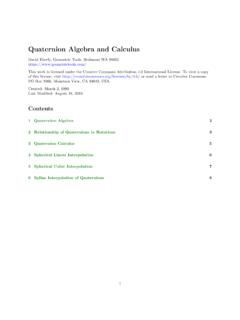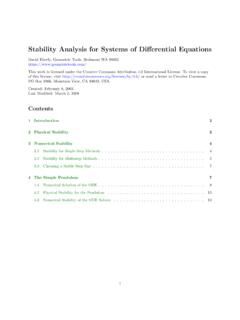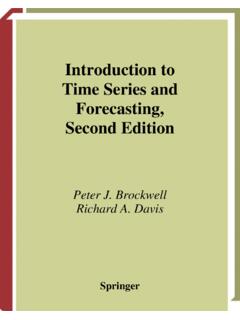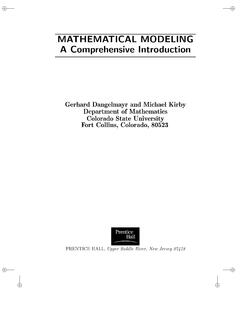Transcription of Least Squares Fitting of Data by Linear or Quadratic ...
1 Least Squares Fitting of data by Linear or QuadraticStructuresDavid Eberly, Geometric Tools, Redmond WA 98052 work is licensed under the Creative Commons Attribution International License. To view a copyof this license, visit or send a letter to Creative Commons,PO Box 1866, Mountain View, CA 94042, : July 15, 1999 Last Modified: September 7, 2021 Contents1 Introduction32 The General Formulation for Nonlinear Least - Squares Fitting33 Affine Fitting of Points Using Height Fitting by a Line in 2 Dimensions.
2 For Fitting by a Line .. Fitting by a Plane in 3 Dimensions .. for Fitting by a Plane .. Fitting by a Hyperplane inn+ 1 Dimensions .. for Fitting a Hyperplane ..94 Affine Fitting of Points Using Orthogonal Fitting by a Line [1 Dimension] .. for the General Case .. Fitting by a Hyperplane [(n 1) Dimensions] .. for the General Case .. Fitting by a Flat [kDimensions] .. for the General Case ..145 Fitting a Hypersphere to Fitting Using Differences of Lengths and Radius.
3 For the General Case .. Fitting Using Differences of Squared Lengths and Squared Radius .. for the General Case .. for Circles .. for Spheres .. Fitting the Coefficients of a Quadratic Equation .. for the General Case .. for Circles .. for Spheres ..256 Fitting a Hyperellipsoid to Updating the Estimate of the Center .. Updating the Estimate of the Matrix .. Pseudocode for the Algorithm ..297 Fitting a Cylinder to 3D Representation of a Cylinder.
4 The Least - Squares Error Function .. An Equation for the Radius .. An Equation for the Center .. An Equation for the Direction .. Fitting for a Specified Direction .. Pseudocode and Experiments .. Fitting a Cylinder to a Triangle Mesh ..438 Fitting a Cone to 3D Estimation of the Cone Axis Direction .. Estimate of the Cone Vertex and Cone Angle ..509 Fitting a Paraboloid to 3D Points of the Form(x,y,f(x,y))5121 IntroductionThis document describes Least - Squares minimization algorithms for Fitting point sets by Linear structuresor Quadratic structures.
5 The organization is somewhat different from that of the previous version of thedocument. Modifications include the following. A section on the general formulation for nonlinear Least - Squares Fitting is now available. The stan-dard approach is to estimate parameters using numerical minimizers (Gauss Newton or Levenberg Marquardt). A new algorithm for Fitting points by a circle, sphere or hypersphere is provided. The algorithm isnon-iterative, so the computation time is bounded and small.
6 In the previous version, the sections about Fitting of points by ellipses or ellipsoids were severely lackingdetails and not useful for developing algorithms. Several algorithms are now provided for such Fitting ,including a general approach for Fitting points by hyperellipsoids. The document for Fitting points by a cylinder has been moved to this document. The website hyperlinkto the cylinder document has been redirected to this document. A section has been added for Fitting points by a single-sided cone.
7 Pseudocode is now provided for each of the algorithms. Hyperlinks still exist for those algorithmsimplemented in the GTE source documents using Least - Squares algorithms for Fitting points with curve or surface structures are avail-able at the website. The document for Fitting points with a torus is new to the website (as of August2018). Least - Squares Fitting of data with Polynomials Least - Squares Fitting of data with B-Spline Curves Least - Squares Reduction of B-Spline Curves Fitting 3D data with a Helix Least - Squares Fitting of data with B-Spline Surfaces Fitting 3D data with a TorusThe document Least - Squares Fitting of Segments by Line or Plane describes a Least - Squares algorithm wherethe input is a set of line segments rather than a set of points.
8 The output is a line (segments inndimensions)or a plane (segments in 3 dimensions) or a hyperplane (segments inndimensions).2 The General Formulation for Nonlinear Least - Squares FittingLetF(p) = (F0(p),F1(p),..,Fn 1(p)) be a vector-valued function of the parametersp= (p0,p1,..,pm 1).The nonlinear Least - Squares problem is to minimize the real-valued error functionE(p) =|F(p)| [dFr/dpc] denote the Jacobian matrix, which is the matrix of first-order partial derivativesof the components ofF. The matrix hasnrows andmcolumns, and the indexing (r,c) refers to rowrandcolumnc.
9 A first-order approximation isF(p+d).=F(p) +J(p)d(1)wheredis anm 1 vector with small length. Consequently, an approximation to the error function isE(p+d) =|F(p+d)|2=|F(p) +J(p)d|2(2)The goal is to choosedto minimize|F(p) +J(p)d|2and, hopefully, withE(p+d)< E(p). Choosing aninitialp0, the hope is that the algorithm generates a sequencepifor whichE(pi+1)< E(pi) and, in thelimit,E(pj) approaches the global minimum ofE. The algorithm is referred to as Gauss Newton a single Gauss Newton iteration, we need to choosedto minimize|F(p) +J(p)d|2wherepis is a Linear Least - Squares problem which can be formulated using the normal equationsJT(p)J(p)d= JT(p)F(p)(3)The matrixJTJis positive semidefinite.
10 If it is invertible, thend= (JT(p)J(p)) 1F(p)(4)If it is not invertible, some other algorithm must be used to choosed; one option is to use gradient descentfor the step. A Cholesky decomposition can be used to solve the Linear Gauss Newton iteration, ifEdoes not decrease for a step of the algorithm, one can modify thealgorithm to Levenberg Marquardt iteration. The idea is to smooth the Linear system to JT(p)J(p) + I d= JT(p)F(p)(5)whereIis the identity matrix of appropriate size and >0 is the smoothing factor.





